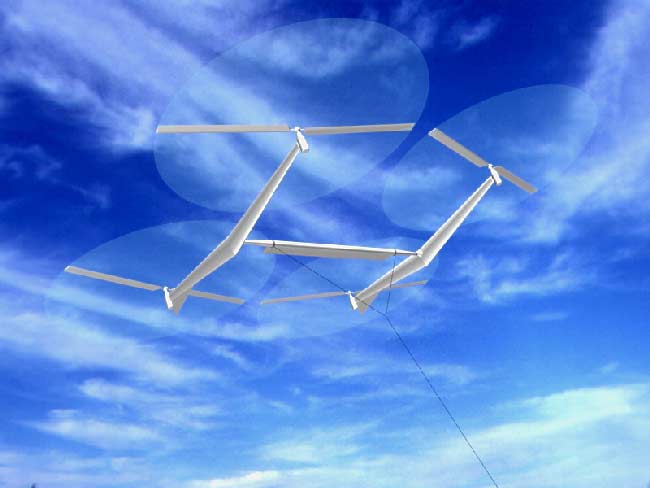Powerful Ideas: Miles-High Kites Could Generate Electricity

Editor's Note: This occasional series looks at powerful ideas — some existing, some futuristic — for fueling and electrifying modern life.
The sky might literally be the limit for wind power — rotors spinning miles high could help supply electricity worldwide.
"There is a huge amount of energy available in high-altitude winds," said researcher Ken Caldeira at the Carnegie Institution's Department of Global Ecology in Stanford, Calif. "These winds blow much more strongly and steadily than near-surface winds, but you need to go get up miles to get a big advantage. Ideally, you would like to be up near the jet streams, around 30,000 feet."
All told, if wind turbines miles above the planet were tethered to 10 percent of the world's land, there is enough energy in these jet stream winds to meet world demand 100 times over, researchers said.
Jet streams are meandering belts of fast winds at altitudes between 20,000 and 50,000 feet. They shift seasonally, but are otherwise persistent features in the atmosphere. Jet stream winds are generally steadier and 10 times faster than wind near the ground, making them a potentially vast and dependable source of energy.
But how to capture the wind so high?
Kites and tethers
Get the world’s most fascinating discoveries delivered straight to your inbox.
A number of technological schemes have been proposed to harvest energy from these high-altitude winds, including tethered, kite-like wind turbines lofted miles high. Up to 40 megawatts of electricity could be generated by current designs and transmitted to the ground via tether.
Using 28 years of weather data, the researchers developed the first-ever global survey of high-altitude wind energy.
"We found the highest wind power densities over Japan and eastern China, the eastern coast of the United States, southern Australia, and north eastern Africa," said researcher Cristina Archer, an atmospheric scientist at California State University in Chico.
These specific areas generate roughly 10 kilowatts per square meter or more. "This is unthinkable near the ground, where even the best locations have usually less than one kilowatt per square meter," Archer added.
The analysis also looked at some of the world's largest cities: Tokyo, New York, Sao Paulo, Seoul and Mexico City. New York proved a prime location, as did the East Asian cities.
"For cities that are affected by polar jet streams such as Tokyo, Seoul and New York, the high-altitude resource is phenomenal," Archer said. "New York, which has the highest average high-altitude wind power density of any U.S. city, has an average wind power density of up to 16 kilowatts per square meter."
Tokyo and Seoul also have high wind power density, as they are both affected by the East Asian jet stream. Since Mexico City and Sao Paulo are located at tropical latitudes, they are rarely affected by the polar jet streams and only occasionally by the weaker sub-tropical jets. As a result they see lower wind power densities than the other three cities.
Issues remain
Another issue is whether implementing such devices on a wide scale could alter general air circulation patterns and thus impact local and global climate. Their simulations hint that if carried to unlikely extremes, blanketing the entire planet with such devices would cool the Earth's surface, reduce precipitation and boost sea ice levels. However, if deployed at levels comparable to total global electricity demand, there seemed to be no detectable effect on the climate even after 70 years.
Also, fluctuating wind strength still presents a challenge when it comes to exploiting this energy source on a large scale, just as it does on the ground.
"While there is enough power in these high altitude winds to power all of modern civilization, at any specific location there are still times when the winds do not blow," Caldeira said. Even over the best areas, the wind can be expected to fail about 5 percent of the time.
"This means that you either need back-up power, massive amounts of energy storage, or a continental or even global scale electricity grid to assure power availability," he added. "So, while high-altitude wind may ultimately prove to be a major energy source, it requires substantial infrastructure."
Archer told LiveScience she did not think high-altitude wind power would solve the entire planet's energy needs by itself — "you don't want something that's not 100 percent reliable. But I am positive that it could play an important role."
Archer and Caldeira detailed their findings online May 26 in the journal Energies.
- Readers Pick : Top 10 Alternative Energy Bets
- Change in the Wind - Power From Thin Air?
- Alternative Energy News & Ideas



